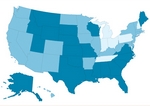Profession
H1N1 exemplifies nation's struggle with public health emergencies
■ A pattern of underfunding is cited as a key factor in why state and federal health departments are largely unprepared for crisis response.
By Christine S. Moyer — Posted Dec. 28, 2009
- WITH THIS STORY:
- » Related content
Complications with fall 2009 production and distribution of influenza A(H1N1) vaccine reveal just how unprepared the nation is to respond to public health emergencies. At the root of the problem is a trend of underfunding public health at federal and local levels, which, if not reversed, will leave the nation more vulnerable to potential threats from natural disasters, foodborne diseases or bioterrorism.
Those are the conclusions of the latest annual report on emergency health preparedness put together by Trust for America's Health, a health policy organization focused on disease prevention, and the Robert Wood Johnson Foundation. The report was released Dec. 15.
The federal government has cut core funding for public health preparedness by 27% (adjusted for inflation) since fiscal 2005, according to the report.
A similar trend can be found at the state level, with 27 states decreasing public health funding from fiscal 2008 to fiscal 2009. Among those with the most precipitous drops were Arizona and South Carolina, with cuts of about 25% and 22%, respectively.
Oklahoma joined the 23 states that increased or maintained level funding during that same time, bolstering public health spending by about 14%. But public health leaders there are still concerned about the state's financial future, as Oklahoma's budget continues to tighten.
"I think the challenge is going to be going forward -- just really doing as best we can with a limited amount of money," said Scott Sproat, chief of Emergency Preparedness and Response for the Oklahoma State Dept. of Health.
Examining states' public health preparedness
The report, "Ready or Not? Protecting the Public's Health from Diseases, Disasters, and Bioterrorism" examined each state's public health preparedness level to better gauge the nation's response capabilities as a whole. The authors gathered data from a variety of sources, including the Centers for Disease Control and Prevention, the Dept. of Health and Human Services and the Assn. of Public Health Laboratories, which represents government-run laboratories that monitor and detect public health threats.
States were graded on their ability to meet 10 indicators, which the report considers integral parts of overall public health emergency capabilities. In addition to emergency preparedness funding, the indicators included states' stockpiles of federally subsidized antivirals, systems for disease surveillance, funding for public health services and availability of hospital beds.
States received one point for achieving each indicator. Montana scored as the least prepared, with three points. On the high end, with nine points each, are Arkansas, Delaware, New York, North Carolina, Oklahoma, Texas and Vermont.
It is clear that where people live can determine how well they are protected from threats to their health, the study's authors said. This disparity among states was particularly evident with H1N1 vaccine distribution.
While the CDC estimates that about half the states now have a large enough supply to open H1N1 vaccines to the general public, others are still struggling to immunize their high-risk populations.
"As serious as the H1N1 outbreak has been, we got off pretty easy as a country. It was a relatively mild strain of flu," said Irwin Redlener, MD, director of the National Center for Disaster Preparedness at the Columbia University Mailman School of Public Health in New York. Dr. Redlener provided peer review for the "Ready or Not?" report.
"One shudders to think how serious this could have been if the virus had been a little different," Dr. Redlener said. "Or what if we had a second disaster on top of this? ... We would have really been in trouble."
Montana, which received the fewest points in the study, began administering the H1N1 vaccine to the general public Dec. 12, said Jim Murphy, bureau chief of communicable disease control and prevention for the state's Dept. of Public Health and Human Services.
Murphy said Montana's low score initially disappointed him. But several of the indicators that made up the grades are not priorities in his state.
For example, he pointed to Montana's lack of liability protection for businesses that provide emergency or disaster relief services. The state's Legislature gave that protection last year to physicians and other health care practitioners, Murphy said, but did not extend them to others, because lawsuits haven't been an issue. "We have great cooperation from the businesses responding to health events."
However, the indicators did highlight some of the state's challenges, including an inability to adequately staff health laboratories. "Finding qualified lab workers in Montana has been a struggle. There are always two or three vacant positions in the lab," Murphy said.
Solving the problems
The Trust for America's Health report follows HHS Secretary Kathleen Sebelius' call for a review of the federal government's system for handling public health emergencies. She made that announcement Dec. 1 at the AMA's National Congress on Health System Readiness in Washington, D.C.
There is recognition at a high federal level that gaps exist in the nation's vaccine manufacturing capacity and capabilities. Sebelius said the review she requested will, in part, identify the cause of these problems and then help craft a plan to remedy them.
Aiming for more immediate changes in the public health sector, the Trust for America's Health report issued a series of recommendations, including increasing federal preparedness funds for health care systems and state and local health departments. The report also urged health care organizations to strengthen regional consortiums to plan for emergencies and develop ways to boost staff.
"This report has always been, and will be, a call to action, and the fact is that the country has made some important progress in preparedness," Dr. Redlener said. "But we are a very long way still from being in a place where we can say the United States is secure and safe from a wide range of threats."












